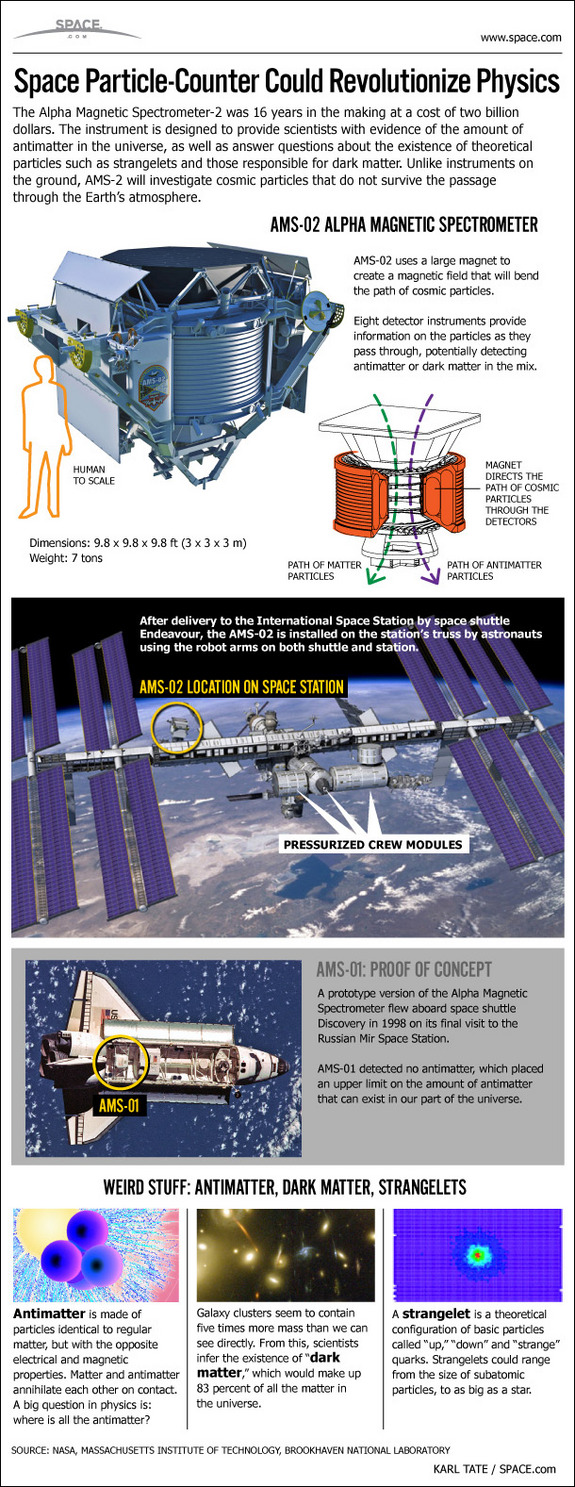Alpha Magnetic Spectrometer-2
An instrument designed to give scientists proof of the amount of antimatter present in the universe and answer questions on the existence of theoretical particles like strangelets as well as those accountable for dark matter, the Alpha Magnetic Spectrometer-2 investigates cosmic particles that don’t survive the passage through the atmosphere of Earth.
An AMS prototype named AMS-01 was flown into space aboard Space Shuttle Discovery in June 1998. It detected no antimatter that established an upper limit on the quantity of antimatter that can be present in our portion of the universe. It also confirmed that the detector concept actually worked in space. After the flight of AMS-01, the development of AMS-02 started, which involved the work of five hundred scientists from fifty-six institutions and sixteen nations organized under DOE (United States Department of Energy) sponsorship.
The instrument that eventually developed from an extensive evolutionary process is the most advanced particle detector sent into space, contending extremely large detectors utilized at major particle accelerators. Its goals have changed and been improved over time. The power requirements for the Alpha Magnetic Spectrometer-2 were believed to be excessively great for a common independent spacecraft. Thus, it was made to be installed as an outer module on the International Space Station as well as draw on power from the ISS.
Module Design
The AMS-02 employs a huge magnet to produce a magnetic field, which will bend the cosmic particles’ path. Eight detector instruments give information on the particles as they traverse, possibly detecting dark matter or antimatter in the mix. These detector instruments include:
• Transition radiation detector. It measures the speed of particles with the highest energy.
• Star tracker. It determines the module’s orientation in space.
• Upper time and lower time of flight counter. It measures the speed of particles with lower energy.
• Permanent magnet. This bends the charged particles’ path in order for them to be identified.
• Silicon tracker. It measures the charged particles’ coordinates in the magnetic field.
• Ring imaging Cherenkov detector. It measures the speed of fast particles.
• Anti-coincidence counter. It discards stray particles that break in through the sides.
• Electromagnetic calorimeter. It measures the particles’ total energy.
Antimatter
While antimatter is made of particles similar to regular matter, it contains the opposite magnetic and electrical properties. Antimatter and matter obliterate one another on contact. But here is a big question – where’s all the antimatter?
Dark Matter
Galaxy clusters appear to have 5 times more mass than what can be seen directly. Thus, scientists deduced the presence of dark matter that would make up eighty-three percent of all the matter within the universe.
Strangelets
Strangelets are a theoretical pattern of basic particles named up, down as well as strange quarks. It could range from the size of a subatomic particle to as large as a star. Strangelets might also have very large mass and extremely small charge-to-mass ratio. It would be a completely new type of matter. AMS-02 may find out whether this strange matter is present in the local environment.




